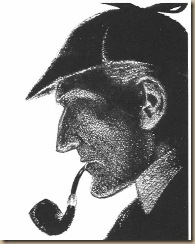 As part of my “post-Christmas confection” of taking Sherlock Holmes cases and modern procedurals I’ve decided to combine the characters and methods from Bones with the Sherlock Holmes story The Adventure Of The Norwood Builder story from The Return Of Sherlock Holmes. This was actually the story that that cause me to develop this idea – to the degree that I did develop it – and the pairing is made for what will become obvious reasons.
As part of my “post-Christmas confection” of taking Sherlock Holmes cases and modern procedurals I’ve decided to combine the characters and methods from Bones with the Sherlock Holmes story The Adventure Of The Norwood Builder story from The Return Of Sherlock Holmes. This was actually the story that that cause me to develop this idea – to the degree that I did develop it – and the pairing is made for what will become obvious reasons.For reasons about as logical as they are in most of the cases that Booth and Brennan confront FBI Agent Sealey Booth and his partner/lover/baby mama Dr. Temperance Brennan are sent to investigate the murder of Jonas Oldacre, a retired builder. The local police have already arrested John McFarlane, a young lawyer for the crime. McFarlane has everything needed to be guilty. He had the opportunity – he was at the victim’s home on the night that the crime was committed – he had motive – Oldacre had asked him to draw up a will for the builder which left everything to McFarlane – and he brought the weapon – MacFarlane’s walking stick with blood on it (hey, in the 1890s people carried walking sticks, and it’s important to the plot). Oldacre’s safe was found open, his papers rifled through, MacFarlane’s bloodied cane was found in the room, there were drag marks across the carpet through the French doors to a pile of building timbers that Oldacre found on the property. The wood pile has been on fire and Oldacre’s housekeeper reported smelling “burning flesh” from the fire. When Booth and Brennan arrive they find the FBI “Bluejackets” (the nameless and faceless – and usually lineless – FBI crime scene techs who are always there when Booth and Brennan get to a crime scene) are going through the ashes of the woodpile. They’ve already found Oldacre’s trouser buttons.
And stop. Because this is where Doyle’s story fall flat on its coccyx. Not to blow the whole story but there’s no body in the woodpile. Or at least not a human body; at the end of the story Holmes assumes that the perpetrator used a couple of rabbits to provide the smell of burning flesh which the housekeeper reported. The assumption on Doyle’s part is apparently that the heat of the fire would totally consume the rabbit corpses and everyone would assume that a human corpse would also be burned, not just beyond recognition but totally to ash. The problem is that the heat of a wood fire would not be sufficient to totally destroy a human body; modern crematoriums usually operate at between 1600 and 1800 degrees F. If it was hot enough to so totally destroy the body that you wouldn’t know it was rabbits, it would probably be enough to destroy the trouser buttons, So even the “Blujackets” would recognise the difference between a rabbit carcass and 54 year-old man with or without trouser buttons. Which in turn means that not only is there no proof that MacFarlane killed Oldacre but no evidence that Oldacre was even dead. And yet Holmes spends most of the story despairing over whether or not he will be able to clear MacFarlane until the real villain – Oldacre himself – makes a crucial mistake.
To be fair, the producers of the Jeremy Brett Sherlock Holmes series recognised the absurdity of the rabbits and substitutes in the body of a tramp that Oldacre murdered because he was the same size and weight as the builder. So, to make this go on a bit longer, let’s do that and turn Booth, Brennan and the Jeffersonian crew loose on that.
The body is taken back to the Jeffersonian. Dr. Camille Saroyan doesn’t have much to do although she can probably get enough tissue for DNA comparison with the blood on the walking stick. This causes a bit of a problem in setting up the timeline. For the purpose of the story MacFarlane has to leave the house late at night – the story says around midnight – because his reason for not taking his hat and walking stick and exiting the front door is so as not to disturb Oldacre’s housekeeper. If the tramp is going to be killed with the walking stick, Oldacre has to lure him to the house, kill him, plant him in the woodpile and start the fire after MacFarlane has left at midnight. If he kills the tramp ahead of time and hides the body in the woodpile until needed he has to get blood for the walking stick.
Meanwhile, Brennan and whichever “squintern” is working this week are stripping the flesh from the bones. Assuming that Oldacre killed the tramp after MacFarlane left she should be able to determine the height and relative strength of the person who dealt the killing blow. On the other hand if the tramp was killed beforehand she’d be able to determine by blood in the shattered bone that the blow delivered by MacFarlane’s cane was not the killing blow. Moreover she’d also be able to determine that the tramp wasn’t standing when the blow from the walking stick was struck.
The big break in the case would of course come from Angela Montenegro, the artist who does the facial reconstructions on her whizbang computer set-up. It will take her about as much time as it took me to read the original story and figure out that this would make an interesting (?) piece for my blog to come up with a face that was most definitely not Jonas Oldacre and that no one, not MacFarlane, not MacFarlane’s mother and not Oldacre’s housekeeper would recognise as Oldacre. With the evidence from Cam, Tempie and Angie, there is no way an even half-way competent prosecutor would have issued an arrest warrant for John MacFarlane.
Of course, in the story the big break in the case comes when Lestrade comes to gloat to Holmes about a new bit of evidence in the case, MacFarlane’s bloody thumb print near the hat rack near the front door where MacFarlane’s hat was hanging. Holmes realises that the print hadn’t been there when he first viewed the crime scene, and determines that someone used a wax impression on sealing wax to make a wax “positive” mould of the print.. He sets out to measure the length of the ground floor of the house and of the top floor and determines that there is a hidden room in the house. He literally smokes Oldacre out by having some constables burn some straw and shout fire, forcing Oldacre to escape the “burning” house. On our modern reality of course, the FBI “Bluejackets” and the local cops would have photographed every blood stain and taken finger prints in the murder scene, and probably in the front hall as well, so they would know that there wasn’t a fingerprint where one suddenly appeared. A modern criminal probably wouldn’t have made this sort of error. And in truth I doubt that today Oldacre would have stuck around his house after framing MacFarlane. Since Oldacre’s motive in trying to frame MacFarlane was not just to get revenge on the young man’s parents but to also to escape with his money and avoid paying his creditors it would make sense for him to flee immediately when it wouldn’t have in the days when one travelled on foot, on horseback or bicycle, or in some sort of wagon or carriage. Now if he’d transferred his funds in the way that he did in the story – mailing checks to a fictitious identity, it would make him a bit harder to trace, but why do that when the funds can be transferred to a numbered off-shore account and then moved around some more electronically. In short, I’m not absolutely sure Booth would have arrested Oldacre. That would be for more talented writers than I to figure out.
